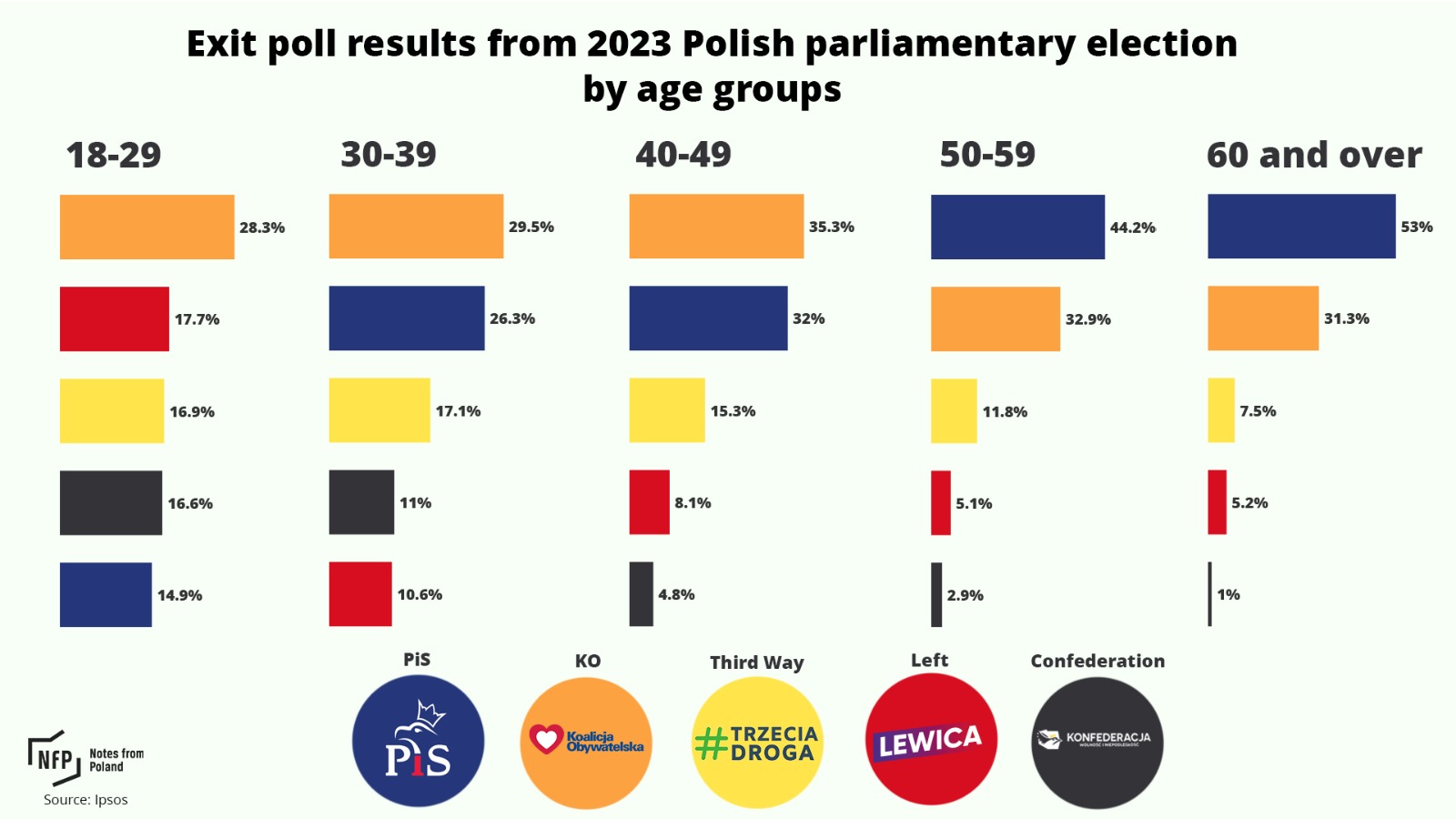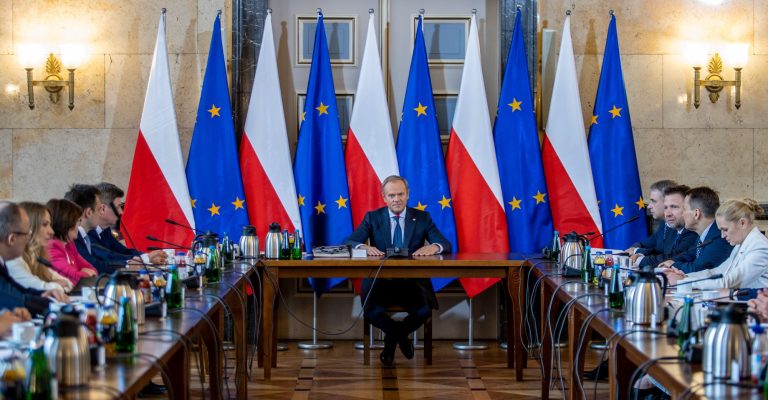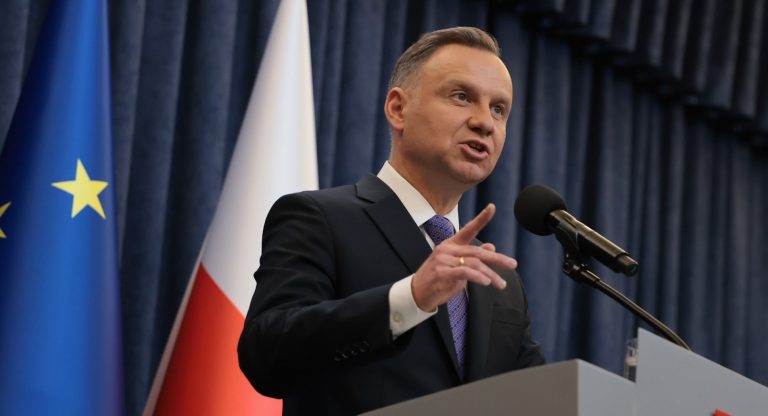What are the Polish left’s post-election prospects?

By Aleks Szczerbiak
Although the left looks set to return to government after 18 years, its vote share actually went down in last month’s election and it risks being subsumed within a coalition dominated by more economically liberal and socially conservative groupings.
The Polish left’s strategic dilemma remains that less well-off, economically leftist voters incline towards parties that are right-wing on moral-cultural issues but also support high levels of social welfare, while “left-wing” socially liberal voters are often also quite economically liberal.
A bittersweet election result
In recent years, the Polish left has enjoyed considerable influence on public debate. Many of its policy stances on both socio-economic and moral-cultural issues now enjoy widespread support and have been adopted by more liberal and centrist political groupings. However, this has not been matched by electoral success.
Left-wing views among young Poles have reached their highest ever level in regular polling conducted since the fall of communism in 1989.
For the first time, left-wing views are stronger among the young than both right-wing and centrist ones https://t.co/bn95iYTOIe
— Notes from Poland 🇵🇱 (@notesfrompoland) February 8, 2021
For much of the post-1989 period, the most powerful political force on the left was the communist successor Democratic Left Alliance (SLD), which governed Poland in 1993-97 and 2001-5. However, SLD’s support collapsed at the 2005 parliamentary election following a series of spectacular high-level corruption scandals.
It contested the 2015 election as part of the United Left (ZL) coalition but narrowly failed to cross the 8% parliamentary representation threshold for electoral alliances (5% for individual parties). As a result, left-wing parties did not secure parliamentary representation for the first time since 1989.
SLD faced a challenge on its radical left flank from the Together (Razem) party, which gained kudos among many younger, left-leaning Poles for its dynamism and programmatic clarity. It accused SLD of betraying left-wing ideas by pursuing orthodox liberal economic policies when in office.
In the event, Together won 3.6% of the vote in 2015 which was not enough to obtain parliamentary representation but meant that it peeled away sufficient left-wing votes to prevent the United Left from crossing the 8% threshold. However, Together failed to capitalise on its early promise and attract a broader range of support beyond the well-educated urban “hipsters” that formed its core electorate.
After 18 years of alternating rule between PiS and PO, 80% of young Poles say they are frustrated with the political situation.
Many are instead being drawn to The Left and the far-right Confederation, writes @RBroszkowski https://t.co/5UEkXQosjj
— Notes from Poland 🇵🇱 (@notesfrompoland) September 25, 2023
,In 2019 another left-wing challenger party emerged in the form of the social liberal Spring (Wiosna) grouping formed by veteran sexual minorities campaigner Robert Biedroń, at the time the Polish left’s most popular and charismatic politician.
However, after a promising start Spring struggled to carve out a niche for itself and only just crossed the 5% representation threshold in that year’s European Parliament (EP) election, well below expectations.
Consequently, these three parties contested the 2019 legislative election as a united Left (Lewica) slate and finished third with 12.6% of the votes, regaining parliamentary representation for the left after a four-year hiatus.
Many left-wing activists and commentators hoped that the new Left parliamentary caucus would use this platform to shift the terms of the debate decisively to the left and challenge the right-wing and liberal-centrist duopoly that has dominated Polish politics since 2005.
SLD changed its name to the New Left (Nowa Lewica) and merged with Spring, although Together chose to maintain its organisational independence and distinctive ideological identity.
The main groups on Poland’s left have agreed to stand jointly at this year’s elections.
„The left is a guarantee that the future, democratic Poland will be pro-social, a Poland where we will not forget about those who are weaker,” says @ZandbergRAZEM https://t.co/l3xsjCtnEf
— Notes from Poland 🇵🇱 (@notesfrompoland) February 28, 2023
In fact, last month’s parliamentary election results were bittersweet for the Left. On the one hand, opposition parties won enough seats to secure a parliamentary majority and it looks set to become the first left-wing grouping to join a Polish government for 18 years.
On the other hand, the Left lost half a million electors as its vote share fell to 8.6% which translated into only 26 seats in the 460-member Sejm, Poland’s more powerful lower parliamentary chamber.
This was 23 fewer than in 2019, making it only the fourth largest parliamentary grouping, and means that the Left will return to office as the smallest member of a governing coalition dominated by liberal- and agrarian-centrist parties.
Lacking a distinctive appeal
So why did the Left perform so badly? Firstly, its election campaign often came across as dull and imaginative, with even politically sympathetic commentators acknowledging that it lacked emotional impact and a strong and clear overarching narrative about what the grouping stood for and how it would govern differently from other parties.
Indeed, during much of the campaign, the Left behaved as if its overriding priority was simply to work with other opposition parties and remove the right-wing Law and Justice (PiS) grouping, Poland’s governing party since 2015, from office.
This encouraged many of its potential supporters to switch to the larger liberal-centrist Civic Platform (PO), Poland’s ruling party between 2007-15 and subsequently the main opposition grouping.
Put simply, the Left did not do enough to stress its distinctiveness as an independent political actor, particularly given that over the last few years Civic Platform has pivoted strongly to the left on both socio-economic and moral-cultural issues.
Opposition leader @donaldtusk has pledged to simplify the gender-recognition process for trans people and introduce same-sex civil partnerships if he wins next month’s elections.
LGBT people are a „victimised minority” in Poland, he says https://t.co/CwQqkVC4rY
— Notes from Poland 🇵🇱 (@notesfrompoland) September 22, 2023
The fact that the Left focused much of its fire on the smaller radical right free-market Confederation (Konfederacja) grouping also helped create the sense that it was competing for voters on the periphery rather than at the core of the Polish party system.
Indeed, the Left appearing to acknowledge that it would only be a junior partner in a future anti-PiS government also had a de-mobilising effect on its potential supporters, which even the most effective political marketing would have had difficulty in overcoming.
An exit poll conducted for the Ipsos agency found that only 57.6% of 2019 Left voters stuck with grouping in 2023, while 23.8% switched to Civic Platform (which secured 30.7% support overall and 157 seats) and a further 12.9% to the Third Way (Trzecia Droga), an agrarian- and liberal-centrist electoral coalition (which also finished ahead of the ‘Left’ with 14.4% and 65 seats).
The opposition groups likely to form the next government have signed a coalition agreement
They pledged to:
– restore rule of law
– annul the near-total abortion ban
– depoliticise public media
– prosecute anti-LGBT hate speech
– separate church and state https://t.co/lwQvGGok8s
— Notes from Poland 🇵🇱 (@notesfrompoland) November 10, 2023
Not winning enough younger women, losing older voters
The Left had hoped to tap into the political mobilisation generated by the huge demonstrations that erupted in October 2020 when Poland’s constitutional tribunal ruled that abortions in cases of foetal defects were unconstitutional.
Poland already had one of Europe’s most restrictive abortion laws, and the tribunal’s ruling meant that the procedure was legal only in cases where pregnancy put the life or health of the mother in danger or if it resulted from incest or rape.
The abortion protests were among the largest in Poland since 1989. Many young Poles were no doubt attracted by their carnival atmosphere at a time when the scope for social interaction was severely limited by coronavirus pandemic restrictions, but some commentators also argued that they were a formative political experience for those who participated in them, particularly younger women.
However, although several of the ‘Left’’s leading figures were at the forefront of these protests, they did not appear to provide the grouping with an electoral boost. While the Left secured an above-average vote share of 10.1% among women (compared to 6.9% among men) this was considerably less than it was hoping for given how much of its campaign messaging was focused on trying to attract female voters.

The Left did attempt, to some extent at least, to showcase some its most effective female leaders, who promoted the grouping’s policy promises on issues such as liberalising the abortion law. The Left was, for example, the only political grouping to be represented by a woman, Joanna Scheuring-Wielgus, during the sole televised party leaders’ debate.
However, for a political formation that professed to be in favour of greater women’s representation (by mandatory quotas if necessary), it foregrounded male politicians during many of the most high-profile campaign moments.
For example, it was New Left joint leaders Biedroń and veteran ex-communist Włodzimierz Czarzasty who spoke on the main platform during the opposition’s huge ‘March of a Million Hearts’ (Marsz Milion Serc) in Warsaw two weeks prior to the election.
The Left has pledged to introduce a 35-hour working week if it comes to power in October’s elections.
It also unveiled three female co-leaders to join its existing three male ones.
„We’re like the Avengers, we have superpowers,” said @RobertBiedron https://t.co/zW8vcDuw8z
— Notes from Poland 🇵🇱 (@notesfrompoland) September 4, 2023
For sure, the Left secured the support of 17.7% of under-30s, among whom there was also a huge increase in turnout, the second highest vote share after Civic Platform on 28.3%.
But this was the same proportion as the grouping won in 2019 and, again, it was hoping for considerably more, particularly given that in 2020 the CBOS polling agency found that the number of Poles aged 18-24 who identified with the political left had nearly doubled from 17% in 2019 to 30% in 2020 (the highest number recorded since the collapse of communism), rising to 40% among young women.
However, particularly disappointing for the Left was the massive defeat that it suffered among older voters: it only secured 5.1% of 50–59-year-olds and 5.2% among over-60s.
For years, this demographic had comprised one of the Polish left’s most important electoral constituencies, especially the (admittedly declining) section of the electorate that had some kind of positive sentiments towards, or direct material interests linking them to, the previous communist regime, such as those families who were connected to the military and former security services.

Responsibility without influence?
Moreover, although the 26 ‘Left’ MPs are theoretically indispensable to a future government formed by the current opposition parties, the grouping risks being subsumed within an administration dominated by larger centrist parties whose instincts are more economically liberal or socially conservative – and, therefore, unable to implement its flagship policies.
For example, the expected new government’s preliminary coalition agreement lacked a specific pledge to liberalise the abortion law in line with the Left’s programme because the Polish People’s Party (PSL), the moderately socially conservative grouping that makes up one-half of the Third Way, made it clear that they oppose this.
The Left really needs to carve out a niche for itself by securing control of ministerial portfolios where it can make an impact either by advancing its political agenda on moral-cultural issues or where its socio-economic policy pledges are not reined in by overall government budget constraints.
One member of Poland’s likely new ruling coalition, The Left, says polls show a majority in favour of abortion on demand.
In fact, they do not. And this issue is likely to be one of the hardest for the incoming government to resolve, writes @danieltilles1 https://t.co/4Nze9wwEC3
— Notes from Poland 🇵🇱 (@notesfrompoland) November 20, 2023
In fact, the Left is divided on how to operate most effectively in the new parliament. While politicians from the more centrist New Left will take up government ministerial positions, the seven deputies who represent Together have decided not to formally join the coalition having failed to secure firm pledges on abortion and financial guarantees for the implementation of its social policy programmes in areas such as health care and housing.
However, Together has said that it will vote to install the new government in a forthcoming parliamentary confidence vote. The problem with this approach is that risks leaving Left supporters feeling that their votes have been wasted while, at the same time, Together is propping up – and, therefore, still being held responsible for (while having even less influence upon) – the new government.
The Polish left’s strategic dilemma
In fact, even if the Left can finesse this and carve out a distinctive role for itself within the new administration, it still faces a long-term strategic dilemma.
Many more Poles declare their attachment to left-wing views (around 20% according to 2020 CBOS data) than actually vote for the Left. However, in Poland, declarations of left-right self-placement are generally determined by attitudes towards moral-cultural issues rather than including traditional left-wing socio-economic concerns.
Indeed, less well-off, economically leftist voters tend to be more socially conservative, so often incline towards parties such as PiS that are right-wing on moral-cultural issues but also support high levels of social welfare and greater state intervention in the economy.
For example, only 5.1% of workers voted for the Left (its highest vote share, 21.9%, was actually among students) while 50.4% supported PiS. Although the Left did include social programmes in its election platform, for most Poles it was associated primarily with moral-cultural rather than socio-economic issues.
At the same time, the kind of younger, better-off, socially liberal voters who in Western Europe would incline naturally towards left-wing parties, in Poland are often also quite economically liberal. So, there is always a risk that these voters will support larger liberal-centrist groupings such as Civic Platform, particularly if they (as many of them did in this election) prioritise keeping PiS out of office above all else.

Notes from Poland is run by a small editorial team and published by an independent, non-profit foundation that is funded through donations from our readers. We cannot do what we do without your support.

Aleks Szczerbiak is Professor of Politics at the University of Sussex. The original version of this article appeared here.
Main image credit: Klub Lewicy/Flickr (under public domain)






